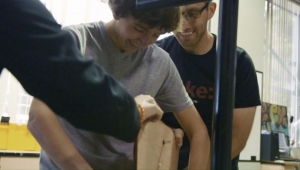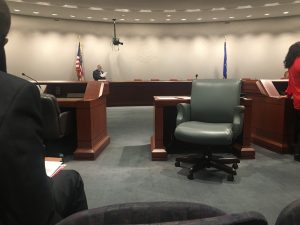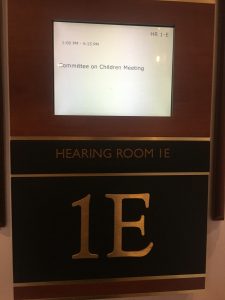Educational inequalities continue persisting in today’s time, creating an achievement gap between certain groups of students. These inequalities exist for many different reasons, some reasons including; race, social class, and poverty. For many years, the government has been trying to figure out a way to close the achievement gap by offering support in areas where they are able to help, starting with providing help to kids from low-income families to get the resources they need in order to go to school and get an effective education. In 1965, President Lyndon B. Johnson passed the Elementary and Secondary Education Act (ESEA), also known as the Title I act, in attempt to offer every child an equal opportunity at education, and potentially close the achievement gap. The ESEA provided an increase of funding to many schools in low-income areas, and was implemented to try and create equality for all students (VCU Library, 2018). Shortly after the ESEA came out, opponents of federal aid had an issue with this bill because they believed that education funds should be controlled by state/local power, rather than federally. The ESEA continued developing overtime, eventually turning into the No Child Left Behind Act (NCLB), implemented by President George W. Bush. The NCLB included funding, annual testing, and consequences for schools that did not meet the NCLB goals (Lee, 2014). This act was very controversial due to the fact that it held schools accountable for low achieving students. This act ended in 2015 when President Obama created the Every Students Succeeds Act (ESSA), which is an emphasis on the ESEA act of 1965. The ESSA continues to try to give every child equal opportunities, along with also emphasizing accountability within schools (US Department of Education, year). Since the ESEA was passed in 1965,, there has been controversy with federal fundings and the federal government being “too” involved in schools, so my question is; how was the ESSA of 2015 put together in Congress as a compromise on past legislation for federal aid for low-income children (ESEA and NCLB)?
Although critics argue that the ESSA was created solely as an extension of previous policies, in doing so they neglect the shortcomings of the No Child Left Behind Act and the Elementary and Secondary Act. Thus, I argue that the ESSA was created in an effort to rectify the failures of NCLB and ESEA by continuing to hold schools accountable, but offering flexibility and freedom to set their own standards and goals. One of the main problems with the NCLB was that it held schools accountable for failing children with high-stakes testing, not taking outside factors into consideration. The NCLB required annual testing, and provided states with goals that students should be meeting (Lee, 2018). On the other hand, the ESSA continues to require annual testing, but the school has more decision on how to handle their testing. They get to pick when they test, how much they test, and what they test. Under the ESSA, states are also able to set their own goals (USA Today, 2015). The ESSA continues to promote educational equality by allowing schools flexibility, but continuing to hold them accountable.
In 1965, President Lyndon B. Johnson passed the ESEA, influenced by the War on Poverty, which “focused attention on the educational needs of poor children and established federal standards to push school districts towards more equitable treatment of disadvantaged students” (Kantor, 1991). The ESEA was the first real movement to change education and promote educational equality. The ESEA provided funding to schools in low-income areas, where there were a lot of students living in poverty. President Lyndon B. Johnson touched on the importance of the ESEA to America in his statement on signing the ESEA. He puts an emphasis on student’s from low-income families, gives them hope for their futures. He states;
“By passing this bill, we bridge the gap between helplessness and hope for more than five million educationally deprived children. We put into the hands of our youth more than 30 million new books, and into many of our schools their first libraries. We reduce the terrible time lag in bringing new teaching techniques into the nation's classrooms. We strengthen state and local agencies which bear the burden and the challenge of better education. And we rekindle the revolution--the revolution of the spirit against the tyranny of ignorance. As a son of a tenant farmer, I know that education is the only valid passport from poverty. As a former teacher--and, I hope, a future one--I have great expectations of what this law will mean for all of our young people. As President of the United States, I believe deeply no law I have signed or will ever sign means more to the future of America.”
Full Statement
In his statement, he stressed the importance of revolutionizing America by changing the way the education system works, and giving every student, even students of low-income that can’t necessarily afford and obtain all the resources that everyone else can an equal opportunity to escape their financial situation.
The ESEA included a lot of federal regulation regarding decisions about schooling and effective teaching, and for 15 years, the ESEA was continuously changing and developing. The ESEA included Title II, which included funds for school libraries and textbooks (VCU Library, 2018). After Title II, the government implemented Title III, which supported education programs when school was not in session.
The ESEA brought a lot of controversial issues. A lot of people believed that funding and where the money ends up should not be controlled by the federal government, it should be controlled by the state and local jurisdictions. Because of this, in 1981, president at the time, Ronald Reagan passed the Education Consolidation and Improvement Act (ECIA). This act was implemented for the purpose of giving states and local governments more control over their education system (Hammond, 1983). There were also problems associated with the ECIA, due to the fact that federal regulation was decreased, and federal funding was also cut by around a billion dollars (Hammond, 1983).
Moving forward to 1999, George W. Bush was just elected president. When he was first elected, he put an emphasis on how education was his top priority, and focused on 4 principles; accountability, putting control where it belongs, parental choice, and researching what works (Sclafani, 2002). Accountability was important to President Bush, because he argued that many times, children that weren’t succeeding as well as others were brushed over and schools were often times not held accountable for their failing children. He then implemented the No Child Left Behind act of 2001. With this act, President Bush put a large focus of attention on assessment and testing. In order to see whether or not children were doing well and were succeeding, he required annual testing, which he believed would help determine strengths and weaknesses, and how to help fix any problems that might arise (Sclafani, 2002). The No Child Left Behind act set goals and standards for all schools, and they would measure whether or not the schools made these goals by using Adequate Yearly Progress (Department of Education, 2009). While signing the No Child Left Behind Act, President George W. Bush stated;
“The story of children being just shuffled through the system is one of the saddest stories of America. Let’s just move them through. It’s so much easier to move a child through than trying to figure out how to solve a child’s problems. The first step to making sure that a child is not shuffled through is to test that child as to whether or not he or she can read and write, or add and subtract. The first way to solve a problem is to diagnose it. And so, what this bill says, it says every child can learn. And we want to know early, before it’s too late, whether or not a child has a problem in learning. I understand taking tests aren’t fun. Too bad. We need to know in America. We need to know whether or not children have got the basic education. No longer is it acceptable to hide poor performance. No longer is it acceptable to keep results away from parents. One of the interesting things about this bill, it says that we’re never going to give up on a school that’s performing poorly; that when we find poor performance, a school will be given time and incentives and resources to correct their problems. A school will be given time to try other methodologies, perhaps other leadership, to make sure that people can succeed. If, however, schools don’t perform, if, however, given the new resources, focused resources, they are unable to solve the problem of not educating their children, there must be real consequences.”
Full Statement
In his speech, he puts the emphasis on testing to make sure that schools are being held accountable. Under the No Child Left Behind act, schools that did not meet their goals multiple times would face consequences. The NCLB Act also required teachers to be highly qualified. Teachers were required to have at least a bachelor’s degree, and be specialized in the subject that they were teaching, and know how to teach it well, and under the NCLB, states would have to do teacher evaluations based on student outcome (Simpson et al., 2004).
Many people had an issue with the No Child Left Behind Act for many different reasons. A general controversy about the NCLB was teacher qualifications. People worried with the amount of stress that they were put under with having to meet the goals presented by the adequate yearly progress, and not getting paid enough to begin with, teachers would either start leaving their careers or people would be hesitant about pursuing a career in education (Simpson et al., 2004). Another big problem with the NCLB act was that it required all students to meet the same goals at the same time, not taking outside factors into consideration (NPR, 2015), for example, whether or not a child had a language barrier, or if a child was already levels behind their peers, they would only have one school year to catch up and meet the Adequate Yearly Progress goals. Also, people also feared that because of these tests, teachers would begin to start teaching only to the test.
Finally, in attempt to rectify the controversial issues that started from the ESEA and NCLB, President Barack Obama implemented the Every Student Succeeds Act (ESSA) in 2015. While signing this into a new act, he stated;
“We’re going to have to have our young people master not just the basics but also become critical thinkers and creative problem solvers. And our competitive advantage depends on whether our kids are prepared to seize the opportunities for tomorrow. And that’s exactly what the Every Student Succeeds Act does. It builds on the reforms that have helped us make so much progress already, holding everybody to high standards for teaching and learning, empowering states and school districts to develop their own strategies for improvement, dedicating resources to our most vulnerable children. With this bill, we reaffirm that fundamental American ideal that every child, regardless of race, income, background, the zip code where they live, deserves the chance to make out of their lives what they will.”
Full Statement:
In President Obama’s statement, he emphasises how education consists of not only learning all the basics, but also soft skills, like critical thinking, solving problems, confidence, etc. He also talks about how with the ESSA, states and school districts will have the ability to set their own goals. Alyson Klein, writer for Edweek, wrote an article on the ESSA. She writes, “ESSA allows states—rather than the federal government—to ride herd on accountability, school improvement, and teacher quality, while requiring them to maintain key protections for vulnerable groups of students, such as minorities, English-learners, and those with disabilities” (Klein, 2018). Under the ESSA, schools are continued to be held accountable by testing, however, the ESSA uses a measuring system that takes into consideration non-academic factors as well (Mathis & Trujillo, 2016). Under the ESSA, students are also allowed 504 plans, which accommodates any student that has a type of learning disability, mental illness, or disability (US Department of Education, 2015).
Also, with the ESSA, teachers are no longer evaluated, and the teacher requirements that were placed under the NCLB act are also no longer required under the ESSA (Edweek, 2015). The ESSA holds schools accountable, while still continuing to offer schools flexibility to do what is best for their area and their students.
In 1964, President Lyndon B. Johnson talked about the War on Poverty in his First State of the Union Address. President Johnson said, “‘Our aim is not only to receive the symptoms of poverty, but to cure it and, above all, to prevent it’”. President Johnson emphasized in this speech that education is the key to solve the War on Poverty (Kantor, 1991), and since the implementation of the ESEA in 1965, there has been a fight for educational equality. Although there have been a lot of controversial issues with the ESEA, NCLB, and even the ESSA, the government has acknowledged the fact that there is a big educational inequality between students from low-income families, and students that come from wealthier families.
Despite the shortcomings of the ESEA and NCLB, they started an important education reform, and they both symbolize the idea that education is a right, and everyone should get an opportunity to obtain the best quality education, no matter race, gender, socioeconomic status, etc. The ESSA contains President Lyndon B. Johnson’s first original idea, and has expanded it, adding important parts from the NCLB act, becoming an act that holds schools accountable, but also offers them flexibility. The ESSA tries to offer every student educational opportunities and equality, and will hopefully expand and come up with more solutions to close the achievement gap.
References
Klein, A. (2018). ESSA Progress Report: How the New Law Is Moving From Policy to Practice. [online] Education Week. Available at: https://www.edweek.org/ew/articles/2018/04/04/essa-progress-report-how-the-new-law.html [Accessed 3 May 2018].
Korte, G. (2018). The Every Student Succeeds Act vs. No Child Left Behind: What’s changed?. [online] USA TODAY. Available at: https://www.usatoday.com/story/news/politics/2015/12/10/every-student-succeeds-act-vs-no-child-left-behind-whats-changed/77088780/ [Accessed 3 May 2018].
Lbjlibrary.org. (2018). President Johnson’s remarks on signing the Elementary and Secondary Education Act – LBJ Presidential Library. [online] Available at: http://www.lbjlibrary.org/lyndon-baines-johnson/timeline/johnsons-remarks-on-signing-the-elementary-and-secondary-education-act [Accessed 3 May 2018].
Lee, A. (2018). No Child Left Behind (NCLB): What You Need to Know. [online] Understood.org. Available at: https://www.understood.org/en/school-learning/your-childs-rights/basics-about-childs-rights/no-child-left-behind-nclb-what-you-need-to-know [Accessed 3 May 2018].
Mathis, W.J. & Trujillo, T.M. (2016). Lessons from NCLB for Every Student Succeeds Act. Boulder, CO: National Education Policy Center Retrieved [Accessed 3 May 2018]. From http://nepc.colorado.edu/publications/lessons-from-NCLB
Sclafani, S. (2018). No Child Left Behind. Issues and Science in Technology, [online] 19(2), pp.43-47. Available at: http://www.jstor.org/stable/pdf/43312298.pdf?refreqid=excelsior:d8ec8e577554b84b3e1081e017e17c80 [Accessed 3 May 2018].
Simpson, R., LaCava, P. and Graner, P. (2018). The No Child Left Behind Act: Challenges and Implications for Educators. Intervention in School and Clinic, 40(2), pp.67-75.
Turner, C. (2018). No Child Left Behind: What Worked, What Didn’t. [online] NPR.org. Available at: https://www.npr.org/sections/ed/2015/10/27/443110755/no-child-left-behind-what-worked-what-didnt [Accessed 3 May 2018].
Whitehouse.gov. (2018). Remarks by the President at Every Student Succeeds Act Signing Ceremony. [online] Available at: https://obamawhitehouse.archives.gov/the-press-office/2015/12/10/remarks-president-every-student-succeeds-act-signing-ceremony [Accessed 3 May 2018].



 es. In response to this, representative Urban revealed that coaches have gotten together and have agreed to do this. The concussion education for coaches would be watching a 30-minute video. Representative William Buckbee spoke up and said, “I don’t know one coach that wouldn’t devote 30 minutes of their day to further ensure the safety of their children”.
es. In response to this, representative Urban revealed that coaches have gotten together and have agreed to do this. The concussion education for coaches would be watching a 30-minute video. Representative William Buckbee spoke up and said, “I don’t know one coach that wouldn’t devote 30 minutes of their day to further ensure the safety of their children”.
